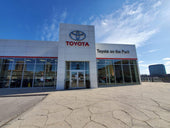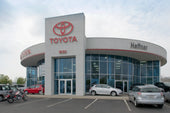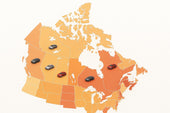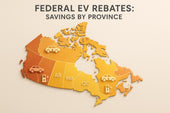When buying a car in Canada, understanding dealer markups and invoice pricing can save you money and reduce stress. Dealer markups include fees added by dealerships for profit, operating costs, or optional extras, while invoice pricing reveals what the dealer pays the manufacturer. Here's what you need to know:
- Dealer Markups: These can include hidden fees, optional add-ons, and even prices above MSRP during high demand. Negotiating is crucial to avoid overpaying.
- Invoice Pricing: This reflects the dealer's cost (often below MSRP) and gives buyers a starting point for negotiations. However, dealers may receive additional incentives that further reduce their costs.
- Transparency Laws: Provinces like Ontario, BC, Alberta, Manitoba, and Quebec enforce all-in pricing rules, requiring dealers to disclose all mandatory fees upfront.
- Consumer Protections: Federal and provincial laws, such as the Competition Act and provincial motor vehicle regulations, protect buyers from unfair practices like hidden fees or misleading pricing.
To negotiate effectively, research invoice pricing, ask for a fee breakdown, and leverage tools like Price Driven for detailed pricing reports. If you suspect violations, report them to provincial regulators like OMVIC or AMVIC. Being informed ensures you get a fair deal and avoid surprises at the dealership.
Invoice Pricing Should You Believe It? Does It Even Matter? Dealers Love To Use This Tactic!
How Dealer Markups Work
Dealer markups highlight the difference between what a dealer pays for a vehicle and the price they sell it for, revealing where additional charges might be added.
Parts of Dealer Markups
Several factors contribute to dealer markups, shaping the final price you pay. A key component is the dealer's profit margin, which is the gap between the invoice price and the selling price. Dealers often pay 5–15% less than the MSRP, thanks to hidden incentives.
Another factor is the dealer holdback, which is typically 1–3% of the MSRP. This amount helps lower the dealer's actual cost compared to the invoice price. For example, on a $40,000 car, the holdback could range from $400 to $1,200, giving dealers additional profit flexibility. Even when buyers negotiate based on the invoice price, there’s still room for dealer earnings.
Optional add-ons, such as extended warranties or protection packages, also increase the final price. Then there are administrative and regulatory fees. For example, Ontario charges an OMVIC fee of $12.50, while Alberta adds an AMVIC fee of $10. Regulatory fees are fixed and non-negotiable, but administrative and documentation fees vary and might be negotiable depending on the dealership.
Hidden Fees and Add-Ons
Beyond the visible costs, dealerships often include hidden fees that aren’t immediately obvious in the advertised price. These can include administration fees, documentation fees, pre-delivery inspection (PDI) fees, and dealer-installed options that you may not have specifically requested.
The presence of these fees depends on provincial rules. In provinces with all-in pricing laws - such as Ontario, Alberta, British Columbia, Manitoba, and Quebec - dealers must include all mandatory fees (excluding taxes and registration) in the advertised price. While this increases transparency, it’s still important to carefully review your invoice to identify any unexpected or negotiable charges.
In provinces without all-in pricing regulations, buyers may face additional fees at the time of purchase. Dealers also benefit from manufacturer-to-dealer discounts, which can reduce their costs by thousands of dollars below the invoice price. This extra profit margin isn’t always visible to buyers, making it even more important to understand the breakdown of costs.
When Dealer Markups Go Above MSRP
Sometimes, market conditions push dealer markups beyond the Manufacturer's Suggested Retail Price (MSRP), forcing buyers to pay premiums for certain vehicles. This often happens during periods of high demand and limited supply, such as with newly released, limited-edition, or highly popular models.
In these cases, dealers may add a "market adjustment" or "additional dealer markup" on top of the MSRP. While this practice is legal in Canada - since MSRP is only a suggested price - it can catch buyers off guard, especially if they’ve based their research on MSRP figures alone.
Regional demand also plays a significant role. For instance, a specific truck model might sell at a premium in one area but go for MSRP or less in another, depending on local market conditions.
Understanding how these pricing practices work highlights the importance of price transparency for Canadian car buyers. Always take the time to examine the details to avoid surprises at the dealership.
Invoice Pricing: A Tool for Clear Pricing
Invoice pricing has changed the game in car buying by giving consumers access to details that were once hidden. It ensures you're not walking into negotiations blind, offering a clearer picture of the costs behind vehicle pricing. This knowledge sets the stage for better negotiations and smarter decisions.
How Invoice Pricing Helps Buyers
Invoice pricing reveals what the dealer pays for a vehicle, which is typically a few percentage points below the MSRP. For instance, if a car's MSRP is $35,000, the invoice price might be closer to $32,000. This difference highlights the potential room for negotiation.
That said, the invoice price isn’t always the dealer’s absolute bottom line. Factors like holdbacks and manufacturer incentives can lower their actual costs even further. This means dealers may have more flexibility than the invoice price suggests, especially when they’re trying to clear inventory or hit sales targets. Knowing this gives buyers a significant advantage, helping them avoid settling for the first offer.
Platforms Supporting Invoice Pricing Access
To make this information more accessible, platforms like Price Driven have stepped in. Price Driven provides transparent details about dealer costs, including hidden incentives and factory discounts that don’t appear on standard invoices. The platform even offers free discount reports, giving buyers a clearer view of dealer-level pricing and helping them negotiate with confidence - or skip the haggling altogether.
Take Lucas H from London, ON, for example. After purchasing a Kia Seltos through Price Driven, he shared that the transparent pricing boosted his confidence and saved him hundreds of dollars. Price Driven also offers pre-negotiated, guaranteed prices with partner dealerships for $99.00. On average, customers save over $700, and in an April 2025 report, 26 out of 32 customers described this approach as a smarter way to buy a car.
The time savings are another major perk. Traditional car buying often involves hours of research and negotiation, but Price Driven users typically spend just five minutes on the pricing process. This transparency not only empowers buyers but also aligns with Canadian consumer protection laws, ensuring all fees and incentives are clearly disclosed.
This approach is particularly helpful in provinces with all-in pricing laws - like Ontario, British Columbia, Alberta, Manitoba, and Quebec - where dealers are required to advertise prices that include all fees except taxes and registration. It’s a win for transparency and for buyers looking to make informed decisions.
sbb-itb-20f5d75
Legal Protections for Car Buyers in Canada
In Canada, consumer protection laws are in place to prevent deceptive pricing tactics and hidden fees when purchasing a vehicle. These protections, which exist at both the federal and provincial levels, aim to safeguard car buyers from unfair practices like undisclosed fees or misleading pricing. The Competition Act and various provincial motor vehicle laws form the foundation of these protections.
Federal and Provincial Consumer Laws
The Competition Act is Canada's main federal legislation addressing misleading advertising, including in the automotive sector. It prohibits false claims about vehicle prices or features, ensuring transparency and honesty in advertising.
Provincially, specific motor vehicle laws provide additional safeguards. For instance, Ontario's Motor Vehicle Dealers Act (MVDA) empowers the Ontario Motor Vehicle Industry Council (OMVIC) to regulate dealer practices and enforce strict pricing standards. Alberta operates under the Motor Dealer Act, with oversight by the Alberta Motor Vehicle Industry Council (AMVIC). Similarly, British Columbia enforces its Motor Dealer Act through the Vehicle Sales Authority (VSA). These provincial regulatory bodies not only oversee compliance but also impose regulatory fees and wield substantial enforcement powers.
Dealer Requirements for Pricing Disclosure
One of the most robust protections for Canadian car buyers is all-in pricing laws. Provinces like Ontario, British Columbia, Alberta, Manitoba, and Quebec require dealers to include all mandatory fees in advertised prices, excluding only HST and licensing fees.
Under these laws, dealers must provide a detailed breakdown of all mandatory costs - such as administrative, inspection, and regulatory fees - while clearly identifying optional add-ons. Items like extended warranties or protection packages must be explicitly presented as optional and cannot be added without the buyer's clear consent.
Transparency doesn't stop at advertising. Dealers are prohibited from introducing new fees after a contract has been signed. They must also clearly disclose any optional or negotiable fees on the invoice. This ensures buyers have a full understanding of the costs involved, reinforcing the transparency measures discussed earlier.
Consumer Options for Pricing Violations
If a dealer violates pricing disclosure rules, consumers have several options to address the issue. The first step is typically to resolve the matter directly with the dealership. If that fails, buyers can escalate the issue by filing a formal complaint with the appropriate provincial regulatory body.
These regulatory authorities have the power to investigate complaints, conduct audits, and monitor advertising for compliance. For example, in Ontario, OMVIC resolved a case where a dealer charged a hidden administration fee after a price had been agreed upon. The investigation confirmed the dealer had breached all-in pricing rules, leading to a mandatory refund for the buyer and penalties for the dealership.
Penalties for violations can include administrative fines, mandatory refunds, and even suspension or revocation of dealership licences. In British Columbia, a dealer faced significant fines for failing to disclose all fees in advertised prices, illustrating the serious consequences of non-compliance.
In addition to enforcement, regulatory bodies run public education campaigns to inform consumers about their rights. These initiatives help buyers identify violations and take appropriate action, empowering them to make informed decisions when purchasing a vehicle.
Dealer Markups vs. Invoice Pricing Comparison
Knowing the difference between dealer markups and invoice pricing can make a huge difference in how much you pay and how confident you feel during negotiations. These two pricing methods sit at opposite ends of the transparency scale, and understanding them can help you approach the car-buying process with more clarity. The table below breaks down their key differences.
Dealer markups tend to benefit the dealership by obscuring the actual cost of the vehicle. When the markup goes beyond the invoice price - or even the MSRP - it leaves buyers guessing whether they’re getting a fair deal. This lack of transparency can result in paying much more than necessary, especially when hidden fees or unnecessary add-ons are involved. While Canadian laws require transparency to protect buyers, the reality is that some dealerships still operate in ways that leave buyers at a disadvantage.
Invoice pricing, on the other hand, gives buyers the upper hand by revealing the dealer’s actual starting cost. This level of clarity allows you to negotiate with confidence, knowing the baseline price. It aligns with Canadian legal standards that mandate clear fee disclosures, making the process more straightforward.
Dealer markups often lead to stressful, high-pressure negotiations, whereas invoice pricing offers a more transparent and less stressful experience. The table below highlights these differences in detail.
Comparison Table: Dealer Markups vs. Invoice Pricing
| Feature | Dealer Markups | Invoice Pricing |
|---|---|---|
| Cost Transparency | Limited; dealer cost is hidden, making it hard to determine fair pricing | High; reveals dealer’s true cost, including incentives and discounts |
| Negotiation Power | Relies heavily on negotiation skills; can involve intense back-and-forth | Empowers buyers with knowledge of dealer costs, enabling smarter negotiations |
| Associated Risks | Risk of overpaying, hidden fees, and add-ons if markups exceed MSRP | Lower risk; easier to confirm fairness, though hidden incentives may still exist |
| Stress Level | High; uncertainty and pressure make for unpredictable outcomes | Low; upfront information reduces stress and often guarantees savings |
| Fee Disclosure | Often incomplete; hidden fees may surface during final paperwork | Typically clear; platforms provide detailed breakdowns |
| Typical Price Level | Above invoice price, sometimes exceeding MSRP depending on market and dealer | Close to dealer cost, often 5-15% below MSRP |
| Legal Protections | Regulated by provincial all-in pricing laws, though practices may vary | Backed by consumer protection laws and enhanced by transparency from platforms |
In Canada, provincial regulations are in place to ensure fee transparency, but their effectiveness can vary depending on the dealership and location. Platforms like Price Driven take this a step further by offering free discount reports that reveal dealer-level pricing, helping you confirm whether advertised prices meet legal standards.
"Knowing how much discount there is, helps with negotiating the price." - Michael S, Vancouver, BC
Key Points for Canadian Car Buyers
When it comes to buying a car in Canada, understanding the difference between dealer markups and invoice pricing can make a big difference in what you pay. Dealer markups often obscure the actual cost of the vehicle, potentially leading to overpayment. On the other hand, invoice pricing gives you a clearer picture of what the dealer paid for the car, equipping you with the information you need to negotiate effectively and land a fair deal.
Canada's legal framework provides strong protections for car buyers, with both federal and provincial regulations in place. The Competition Act prohibits misleading marketing practices, while laws like Ontario's Motor Vehicle Dealers Act and Quebec's Consumer Protection Act require transparent fee disclosures. In provinces with all-in pricing laws - such as Ontario, British Columbia, Alberta, Manitoba, and Quebec - dealers must advertise prices that include all mandatory fees, except for taxes and registration fees. This helps eliminate surprise charges when it's time to sign the paperwork, giving buyers more confidence during negotiations.
However, these protections are only useful if you know your rights. Always ask for a detailed, written breakdown of all fees and charges before committing to a purchase. If you suspect a dealer is not following disclosure laws, you can report them to provincial regulatory bodies like OMVIC in Ontario or AMVIC in Alberta. These agencies have the authority to investigate complaints and enforce penalties if necessary.
Many Canadian car buyers have saved thousands by leveraging invoice pricing data. While invoice pricing provides a solid starting point, it’s important to keep in mind that it doesn’t always show the dealer’s lowest cost. Manufacturers often offer extra incentives to dealers - typically 1–3% of the car's MSRP - that aren’t visible to buyers. To get the best deal, verify all pricing details and stay informed about your province's disclosure rules. Tools like Price Driven can simplify this process by offering free discount reports and pre-negotiated deals through certified partner dealerships.
Preparation is the key to successful car buying in Canada. Know the invoice price, understand your provincial regulations, and don’t hesitate to walk away if the dealer isn’t being transparent. With the right knowledge and the legal protections available, you’ll be in a strong position to navigate the car market with confidence.
FAQs
How can I use invoice pricing to negotiate a better deal on a car in Canada?
Using invoice pricing as a starting point can give you a solid edge when negotiating the purchase of a car. This term refers to the amount a dealership pays the manufacturer for the vehicle, which is typically less than the sticker price. By understanding this number, you can negotiate more effectively, aiming for a price closer to the dealer's cost while still allowing them a fair profit.
To begin, research the invoice price for the car you're interested in. Websites like Price Driven offer tools to find this information, along with pre-negotiated deals and potential dealer discounts. When you sit down to negotiate, use the invoice price as evidence of your preparation and aim for a reasonable amount above it - one that works for both you and the dealership. Don’t forget to factor in extras like fees, taxes, and any current promotions.
Approaching negotiations with knowledge and respect can not only help you land a better deal but also ensure a transparent and positive buying experience.
What can I do if I believe a dealership is violating all-in pricing laws?
If you think a dealership might not be following all-in pricing laws, there are steps you can take to address it. Start by carefully reviewing your purchase agreement to confirm that all fees, charges, and taxes are clearly outlined. In Canada, dealerships are required by law to include all mandatory costs in the advertised price - this excludes sales taxes and optional extras.
If anything seems unclear or misleading, reach out to the dealership directly and ask for clarification. If they don't resolve the issue, you can escalate the matter by filing a complaint with your provincial or territorial consumer protection agency, as they are responsible for enforcing these rules. Be sure to keep copies of all relevant documents, like advertisements and receipts, as they can strengthen your case.
How do dealer holdbacks and manufacturer incentives impact the price I pay for a car in Canada?
Dealer holdbacks and manufacturer incentives play a key role in shaping the final price of a car. Let’s break it down:
- Dealer holdbacks: These are funds reimbursed to the dealer by the manufacturer after a vehicle is sold. This system allows dealers to offer a lower upfront price while still maintaining their profit margins. However, these savings don’t always make their way to the buyer.
- Manufacturer incentives: These include cash rebates or promotional discounts aimed at making vehicles more affordable. Unlike holdbacks, these incentives are often applied directly to reduce the purchase price.
If you’re negotiating a car deal, understanding these elements can give you valuable insight into a dealer’s pricing flexibility. In Canada, laws require pricing transparency, ensuring buyers are protected from unexpected fees. To make things even easier, platforms like Price Driven provide access to clear invoice pricing and pre-negotiated deals, helping you secure the best value for your next vehicle.







































































































































